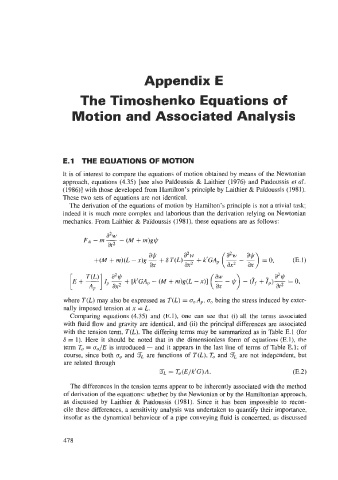Page 508 - Fluid-Structure Interactions Slender Structure and Axial Flow (Volume 1)
P. 508
Appendix E
The Timoshenko Equations of
Motion and Associated Analysis
E.l THE EQUATIONS OF MOTION
It is of interest to compare the equations of motion obtained by means of the Newtonian
approach, equations (4.35) [see also Paidoussis & Laithier (1976) and Pdidoussis et al.
(1986)l with those developed from Hamilton’s principle by Laithier & Paidoussis (1981).
These two sets of equations are not identical.
The derivation of the equations of motion by Hamilton’s principle is not a trivial task;
indeed it is much more complex and laborious than the derivation relying on Newtonian
mechanics. From Laithier & Paidoussis (1981), these equations are as follows:
a2
FA -m- - (M+m)g+
at2
a+ a2w
+(M + m)(L - x)g - + 6 T(L)- + k‘GA, (E. 1)
ax 8x2
where T(L) may also be expressed as T(L) = a,A,, a, being the stress induced by exter-
nally imposed tension at x = L.
Comparing equations (4.35) and (E.l), one can see that (i) all the terms associated
with fluid flow and gravity are identical, and (ii) the principal differences are associated
with the tension term, T(L). The differing terms may be summarized as in Table E.l (for
S = 1). Here it should be noted that in the dimensionless form of equations (E.l), the
term To o,/E is introduced - and it appears in the last line of terms of Table E.l; of
course, since both a, and 3~ are functions of T(L), To and 3~ are not independent, but
are related through
TL = T,(E/k’G)A. (E.2)
The differences in the tension terms appear to be inherently associated with the method
of derivation of the equations: whether by the Newtonian or by the Hamiltonian approach,
as discussed by Laithier & Paidoussis (1981). Since it has been impossible to recon-
cile these differences, a sensitivity analysis was undertaken to quantify their importance,
insofar as the dynamical behaviour of a pipe conveying fluid is concerned, as discussed
478

